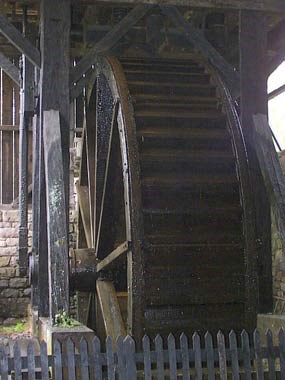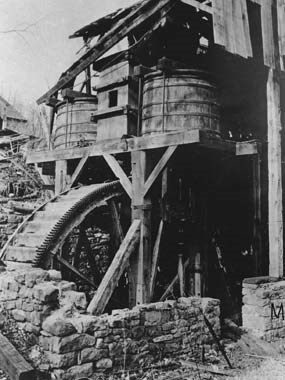
NPS photo. Iron production at Hopewell Furnace required a blast of air to bring the heat of the furnace above 2800 degrees (Fahrenheit). The water wheel supplied the power for this air blast by pumping a pair of pistons inside two blowing tubs. Compressed air moved from the blowing tubs into a receiving box between the tubs, and then through a long pipe to enter the furnace through the tuyere, a cone-shaped nozzle attached to the end of the pipe. The Hopewell water wheel is a 22-foot diameter "breast" wheel which was made predominately of chestnut and oak wood. A breast wheel is commonly found in areas where the headwater is between 5 and 12 feet high. It gets its name from the fact that the water turns the wheel by flowing in halfway up the wheel instead of having the water come in at the top of the wheel, as is the case with an "overshot" wheel, or turning the wheel from underneath, as is the case with an "undershot" wheel. The wheel itself turns when water flows into the spaces in the wheel, called buckets, on one side of the wheel, which then makes that side heavier than the other. Gravity then works on the heavier side of the wheel which causes it to turn. The turning of the wheel can create 5-15 horsepower that can then be used to run the blast machinery of the furnace. In 1805, a 22-foot breast wheel, much like the one that exists today, was built to replace the former 30-foot overshot wheel that had been in use from about 1771 to that time. This happened when the furnace lost rights to the west headwater and Hopewell Dam was constructed to provide a new source of water power. Since the original installation of the 22-foot breast wheel, there have been several instances of the wheel being replaced or repaired:

NPS photo. The idea of using a wheel to harness the power of water and put it to practical use dates back to at least the first century B.C. when the concept was written down by a Roman engineer. There is, however, no evidence that the theory described by this engineer was actually put into practice. Centuries later, in the 1830s, there is evidence that most European monasteries were equipped with water wheels. The wheel continued to evolve from the simple, and less efficient, undershot wheel to the overshot and breast wheels, which could harness not only the power of flowing water, but gravity as well. Water wheels continues to change to meet specific needs and were improved through the use of iron reinforcements, but they were phased out around the 1840s in favor of more reliable, though less visually pleasing, turbines and steam engines. Though water wheels are able to make use of the unending power of water and are also fascinating to see in action, there are several problems and limitations inherent to their use, which help explain why they were ultimately replaced by more versatile and reliable steam engines. The most obvious issue with the water wheel is that it runs on water. This limits its use to places where there is adequate flowing water or where there is water nearby that can be channeled to turn the wheel. Weather is also a factor in the successful operation of a water wheel. If there is a drought, the wheel slows or stops with the reduced flow of water. On the other hand, if there is too much rain the tail race can fill with "back water" which produces friction on the wheel slowing it. If the water freezes in winter, the wheel stops and can be damaged by ice. Other problems arise from the fact that the wheel is made largely of wood and works in water. Even when there are no extreme weather conditions acting on the wheel, general wear on the wheel causes problems. Water damages the wood, particularly the buckets, which causes them to be replaced every few years to keep the wheel running properly. |
Last updated: February 26, 2015
